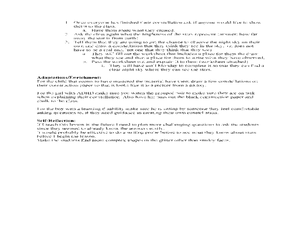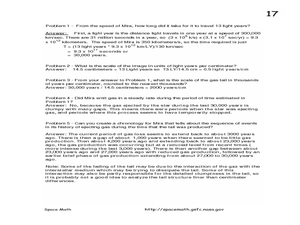Curated OER
Star Light, Star Bright
Four modules are a part of this stellar lesson plan. Space scientists view the electromagnetic spectrum, they generate waves on a computer screen in order to measure frequency and wavelength, discover how light is related to temperature,...
Laboratory for Atmospheric and Space Physics
Star Light, Star Bright
Star light, star bright, first star I see ... wait a minute, where did the star go? Scholars complete a simulation that measures the brightness of a distant star as another object passes in front of it. Learners move the passing object...
University of Colorado
Star Light, Star Bright? Finding Remote Atmospheres
People might be able to breath there. Learners view a simulation of a planet passing in front of a star. Using data from occultations of planets with known types of atmospheres, scholars determine whether the simulated planet has an...
Glynn County School System
Lives and Deaths of Stars
Star light, star bright ... just how long can you wish on that star? Well, it depends on its mass. The presentation explains the life cycle of stars based on their sizes. Scholars learn about the life expectancy of a star based on the...
Curated OER
Star Light...Star Bright
In this brightness of stars worksheet, students use a given formula using the temperature in Kelvins of a star to find its brightness. Students solve 4 problems using this equation.
Curated OER
Star Light, Star Bright: Exploring How Stars are Classified
In this star classification learning exercise, learners are given laminated star charts to make observations about stars. They work in groups to classify groups of stars based on different characteristics. For each group of stars they...
Curated OER
Star Light, Star Bright : Exploring How Stars Are Classified
Learners work in small groups to organize stars into different categories. They consider size, luminosity, color and temperature, organize the groups and ten report their categories to the class.
Curated OER
Stars Lab
After making a list of top 10 brightest stars, your class will learn to classify the colors of the hottest and coolest stars. The spectral classes will help with understanding of nuclear fusion and the life of a star.
Space Awareness
How Light Pollution Affects the Stars: Magnitude Readers
Did you know light can decrease visibility? Light pollution absolutely makes it more difficult to see stars. Scholars build a simple magnitude reader to determine the magnitude of stars. They use these data to estimate the impact of...
NASA
Blinded by the Light!
Pupils learn of multiple ways astronomers look for planets outside of the solar system. By completing a hands-on activity, scholars discover that trying to see the planets directly because of the glare from the nearby star is nearly...
NASA
Just How Far is That Star?
Pupils often wonder how we know the distance to various stars. Starting with a thought experiment and progressing to a physical experiment, they determine the brightness and distance to various stars. The evaluation requires critical...
Curated OER
Where Did All the Stars Go?
For this brightness of stars worksheet, students solve 4 problems given a unit of measurement of cents/second for brightness. Students find cents collected in timed exposures, they find brightness of stars and they determine visibility...
Starry Night Education
The Stars
Three astronomy activities in one resource! Here you will find one hands-on activity, one demonstration, both with discussion questions, and one activity worksheet. During these lessons young scientists discuss how stars are different,...
NASA
Taking Apart the Light
Break down light into spectra. Scholars learn how atoms emit and absorb photons and come to understand how this process allows scientists to identify different atoms based on either absorption lines or emission lines. Learners then...
Curated OER
How is a Star's Color Related to Its Temperature?
In this star color and temperature worksheet, students create a Hertzsprung-Russell diagram in order to determine how star brightness, color, temperature, and class are related. Once diagram is complete, they answer 6 short answer...
It's About Time
Our Community's Place Among the Stars
But isn't the Milky Way a candy bar? Lead a detailed discussion on the complex topic of our solar system and the Milky Way Galaxy as the class explores stellar evolution, structure, and investigates the relationship between luminosity...
Exploratorium
Afterimage
To illuminate how afterimage occurs, create a star, square, or other geometric-shaped light for learners to look at for 30 seconds. Then, have them explain what they see as they shift their focus to a blank wall. A full explanation of...
Curated OER
Size of Stars
Fifth graders draw constellations in the sky and use the brightness levels of stars to show how big they are. In this constellations lesson plan, 5th graders describe what they see in the night sky by discussing the star's distances.
Curated OER
Measuring Star Temperatures
In this measuring star temperatures, students find the temperature of a star using Planck's curve and the Wein Displacement law. Students also find the peak wavelengths for given stars using Planck's curve.
Curated OER
Spitzer Explores a Dusty Young Star
For this stars worksheet, students read about the Spitzer space telescope and they solve 5 problems about the mass, size, and power of dust grains and interstellar mediums detected by the telescope.
Curated OER
A Star Sheds a Comet Tail!
In this comet tails and stars learning exercise, students read about the star Mira and the vast clouds of gases it emits. They use a photograph from the Galaxy Evolution Explorer satellite to solve 5 problems about the scale of the...
Mr. E. Science
Stars, Galaxies and the Universe
It takes 225 million years for our sun to travel around the galaxy. The presentation covers astronomical units, light years, telescopes, types of stars, the life cycle of a star, and types of galaxies. This is the last lesson in a...
Curated OER
Star Light, Star Bright
Students practice the skill of reading while chanting the rhyme of "Star Light, Star Bright" and act out the story while working as a group with the help of the teacher. They also listen to the story on tape and sing the rhyming song.
PBS
Analyzing Light Curves of Transiting Exoplanets
Scientists detected exoplanets by measuring how the brightness of stars changed over time. Young astronomers interpret and analyze the same data that led to exoplanet discoveries. They learn to apply light curve graphs and connect the...

























